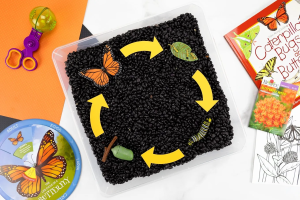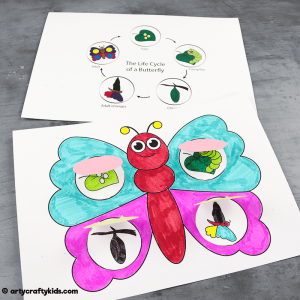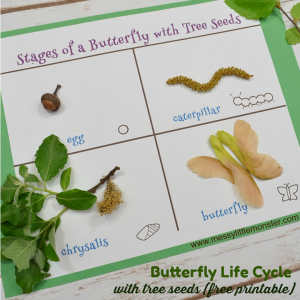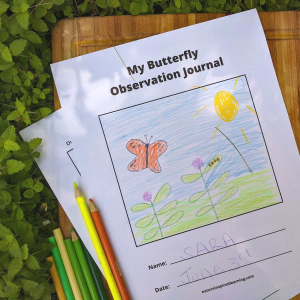Exploring the life cycle of butterflies can be a fascinating and educational experience for preschoolers.
The transformation from a tiny egg to a magnificent butterfly captures their imagination and encourages their curiosity about the natural world.
To make this learning journey even more exciting, we have compiled a list of butterfly life cycle activity for preschoolers.
Activity 1: Butterfly Life Cycle Sensory Bin

Create a sensory bin that represents the different stages of a butterfly’s life cycle. Fill a shallow container with colored rice, shredded green paper, and small plastic eggs. Each plastic egg can hold a corresponding object or picture representing a stage in the butterfly life cycle: an egg, a caterpillar, a chrysalis, and a butterfly. Encourage preschoolers to explore the sensory bin, touch the rice and paper, and discover the hidden objects inside the eggs. As they manipulate and play with the materials, engage them in conversations about the different stages of a butterfly’s life and how it undergoes metamorphosis.
Activity 2: Butterfly Life Cycle Art Collage

Provide preschoolers with various art materials such as construction paper, tissue paper, glue, scissors, and markers. Show them pictures of butterflies at different stages of the life cycle and explain each stage. Encourage them to create a butterfly life cycle collage by cutting and pasting the different materials to represent each stage. They can use tissue paper for the eggs, green paper for the caterpillar, folded paper or tissue for the chrysalis, and colorful construction paper for the butterfly. Display their collages around the classroom or at home, creating a beautiful visual representation of the butterfly life cycle.
Activity 3: Butterfly Garden Observation

Set up a small butterfly garden in your classroom or outdoor area using potted plants that attract butterflies. Choose plants like milkweed, daisies, or lavender. Explain to the preschoolers that these plants are food sources for caterpillars and butterflies. Observe the garden regularly and encourage children to look for eggs, caterpillars, chrysalises, and butterflies. Provide magnifying glasses for a closer look. Guide them in documenting their observations through drawings or by taking pictures. This activity fosters a direct connection between the children and the real-life experience of observing butterflies in their natural habitat.
Related: 20 Exciting No Prep Get to Know You Games for Kids
Activity 4: Butterfly Wing Symmetry Painting

Introduce preschoolers to the concept of symmetry by exploring butterfly wings. Provide each child with a piece of paper folded in half. Help them draw half of a butterfly wing on one side of the fold, and then fold the paper over to create a symmetrical design. Open the paper to reveal the complete butterfly wing. Supply them with paint and brushes, and encourage them to paint their butterfly wings using bright and vibrant colors. This activity not only develops fine motor skills but also introduces the concept of symmetry through a creative and artistic approach.
Activity 5: Butterfly Life Cycle Playdough Mats

Create playdough mats that depict each stage of the butterfly life cycle. Print out or draw pictures of an egg, a caterpillar, a chrysalis, and a butterfly on separate pieces of paper. Laminate the pictures or place them in clear plastic sleeves. Provide preschoolers with different colored playdough and laminated mats. Encourage them to mold the playdough into the shapes and forms of each life cycle stage, placing them on the corresponding mat. As they manipulate the play dough, discuss the characteristics and changes that occur during each stage. This activity combines sensory play, fine motor skills, and cognitive development in an interactive and hands-on way.
Related: 20 Popular After School Activities for Preschool Kids
Activity 6: Butterfly Life Cycle Dramatic Play

Set up a dramatic play area where preschoolers can act out the different stages of a butterfly’s life cycle. Create stations or areas for each stage, such as an “egg-laying” corner with plastic eggs, a “caterpillar munching” area with green leaves and pretend caterpillar toys, a “chrysalis” space with a hanging cloth or sheet, and a “butterfly garden” with flowers and butterfly wings. Encourage children to take on different roles, pretend to be butterflies, and act out the various stages. This activity promotes imaginative play, social interaction, and a deeper understanding of the butterfly life cycle.
Activity 7: Butterfly Life Cycle Sequencing Cards
Print or draw pictures representing each stage of the butterfly life cycle: egg, caterpillar, chrysalis, and butterfly. Laminate the pictures and cut them into individual cards. Mix up the cards and provide them to preschoolers. Instruct the children to work together to arrange the cards in the correct sequence, from the egg to the butterfly. Discuss each stage as they place the cards in order, reinforcing their understanding of the life cycle. This sequencing activity supports cognitive development, and logical thinking, and enhances visual recognition skills.
Activity 8: Butterfly Life Cycle Song and Dance

Introduce a butterfly life cycle song to the preschoolers, such as “The Butterfly Life Cycle Song” by The Learning Station. Teach them the song and create simple dance movements or gestures to go along with each stage of the life cycle. Practice singing and dancing together, incorporating actions that mimic the egg, caterpillar crawling, forming a chrysalis, and fluttering like a butterfly. Encourage children to express themselves through movement and engage their auditory and kinesthetic learning styles. This activity promotes music appreciation, gross motor skills, and coordination.
Activity 9: Butterfly Life Cycle Puzzles

Create butterfly life cycle puzzles using pictures of each stage. Print or draw four separate images, one for each stage, and laminate them for durability. Cut each picture into several pieces, creating puzzle pieces. Mix up the pieces and provide them to the preschoolers. Guide the children to solve the puzzles by matching the pieces to form the complete pictures of each life cycle stage. As they work on the puzzles, discuss the characteristics and changes that occur in each stage. This activity enhances problem-solving skills, hand-eye coordination, and spatial awareness.
Activity 10: Butterfly Life Cycle Snack

Engage the preschoolers in a delicious and interactive snack activity that represents the butterfly life cycle. Provide graham crackers, cream cheese or peanut butter, and various toppings such as blueberries, pretzels, and sliced bananas. Instruct the children to spread the cream cheese or peanut butter on the graham crackers, symbolizing the base of the life cycle. Then, guide them to add the toppings in specific patterns to represent each stage: blueberries for the eggs, pretzels for the caterpillar, and banana slices for the chrysalis and butterfly wings. Enjoy the snack together, discussing the different stages as they munch on their edible representations. This activity combines sensory exploration, fine motor skills, and a tasty treat!
Activity 11: Butterfly Life Cycle Sensory Playdough

Create a sensory playdough activity that allows preschoolers to explore the different stages of a butterfly’s life cycle. Prepare different colors of playdough, each representing a specific stage. For example, green for the caterpillar, brown for the chrysalis, and vibrant colors for the butterfly. Provide various tools and materials, such as small plastic eggs, pipe cleaners, and butterfly-shaped cookie cutters. Encourage the children to mold the playdough into each stage, using the materials to add details and decorations. As they manipulate the play dough, discuss the characteristics and changes that occur during each stage. This activity promotes sensory exploration, fine motor skills, and creative expression.
Activity 12: Butterfly Life Cycle Outdoor Scavenger Hunt

Organize an outdoor scavenger hunt that focuses on finding elements related to the butterfly life cycle. Create a list of items for the children to search for, such as a leaf for the caterpillar’s food, a chrysalis-shaped object, or a flower for the butterfly. Provide magnifying glasses for closer examination. Take the children on a nature walk, guiding them to search for the items on the list. Encourage them to observe and discuss the significance of each item in relation to the butterfly life cycle. This activity combines outdoor exploration, observation skills, and critical thinking.
Activity 13: Butterfly Life Cycle Sensory Storytime

Engage preschoolers in a sensory-rich storytime experience centered around the butterfly life cycle. Select a children’s book that introduces and explores the life cycle stages of butterflies, such as “From Caterpillar to Butterfly” by Deborah Heiligman. Enhance the storytelling by incorporating sensory elements related to each stage. For example, provide soft feathers for the egg stage, textured fabrics for the caterpillar stage, a silky scarf for the chrysalis stage, and colorful ribbons for the butterfly stage. As you read the story, encourage the children to touch and interact with the sensory materials, immersing themselves in the narrative. This activity stimulates sensory perception, language development, and storytelling skills.
Activity 14: Butterfly Life Cycle Sorting Game

Prepare a sorting game to help preschoolers categorize and understand the different stages of the butterfly life cycle. Create large cards or posters with visuals or written descriptions of each stage: egg, caterpillar, chrysalis, and butterfly. Collect various objects or pictures that represent each stage, such as plastic eggs, toy caterpillars, silk scarves, and butterfly wings. Mix up the objects and ask the children to sort them into the corresponding stage. Encourage them to discuss their reasoning behind each classification. This game reinforces classification skills, critical thinking, and knowledge of the butterfly life cycle.
Activity 15: Butterfly Life Cycle Sensory Painting

Introduce a sensory painting activity that allows preschoolers to explore the butterfly life cycle using different textures and materials. Set up a painting station with various materials, such as sponges, cotton balls, bubble wrap, and leaves. Provide different colors of paint and large sheets of paper. Instruct the children to dip the materials into the paint and use them to create textured prints or patterns on the paper. Encourage them to discuss which textures represent each stage of the butterfly life cycle and how they relate to the characteristics of the stages. This activity combines sensory exploration, creativity, and artistic expression.
Activity 16: Butterfly Life Cycle Outdoor Obstacle Course
Create an outdoor obstacle course that represents the different stages of a butterfly’s life cycle. Set up stations or areas that correspond to each stage, such as an “egg-laying” station where children can place small eggs on leaves, a “caterpillar crawl” area where they can navigate through tunnels or under hoops, a “chrysalis rest” spot with blankets or mats to lie down on, and a “butterfly flight” zone where they can run or skip with butterfly wings on their backs. Guide the children through the obstacle course, explaining each stage and encouraging them to complete the tasks at each station. This activity promotes gross motor skills, coordination, and active learning.
Activity 17: Butterfly Life Cycle Fine Motor Sorting

Develop fine motor skills and sorting abilities through a butterfly life cycle sorting activity. Prepare a variety of small objects or pictures that represent each stage of the life cycle. Provide sorting trays or containers labeled with the stages: egg, caterpillar, chrysalis, and butterfly. Instruct the preschoolers to sort the objects or pictures into the correct tray based on the stage they represent. Encourage them to manipulate and place the objects carefully, using their fingers to enhance their fine motor control. This activity enhances hand-eye coordination, classification skills, and cognitive development.
Activity 18: Butterfly Life Cycle Role Play

Engage preschoolers in role play to deepen their understanding of the butterfly life cycle. Provide dress-up clothes, props, and a designated area for dramatic play. Assign roles such as caterpillar, butterfly, flower, or scientist. Encourage the children to act out the different stages and interactions between the characters. Facilitate discussions and guide their play by asking questions about the changes that occur during each stage, the needs of the characters, and the roles they play in the life cycle. This activity promotes imaginative play, social interaction, and language development.
Activity 19: Butterfly Life Cycle Science Journal

Introduce the concept of a science journal to preschoolers and guide them in creating their own butterfly life cycle journal. Provide blank journals or notebooks, along with coloring materials, stickers, and writing utensils. Encourage the children to decorate their journal covers and draw or write about each stage of the butterfly’s life cycle. Encourage them to make observations, ask questions, and document any changes or discoveries they encounter during their learning journey. This activity fosters literacy skills, scientific inquiry, and reflection.
Activity 20: Butterfly Life Cycle Virtual Field Trip

Take preschoolers on a virtual field trip to a butterfly garden or butterfly conservatory. Find online videos or interactive websites that allow children to explore and learn about butterflies and their life cycles. Before the virtual trip, prepare discussion questions and prompts to engage the children during and after the experience. Encourage them to observe the different stages, ask questions, and share their thoughts and feelings about what they see. Follow up the virtual field trip with related activities, such as drawing or painting butterflies, writing or dictating butterfly facts, or creating butterfly-themed crafts. This activity combines technology, virtual exploration, and active engagement in learning about the butterfly life cycle.

